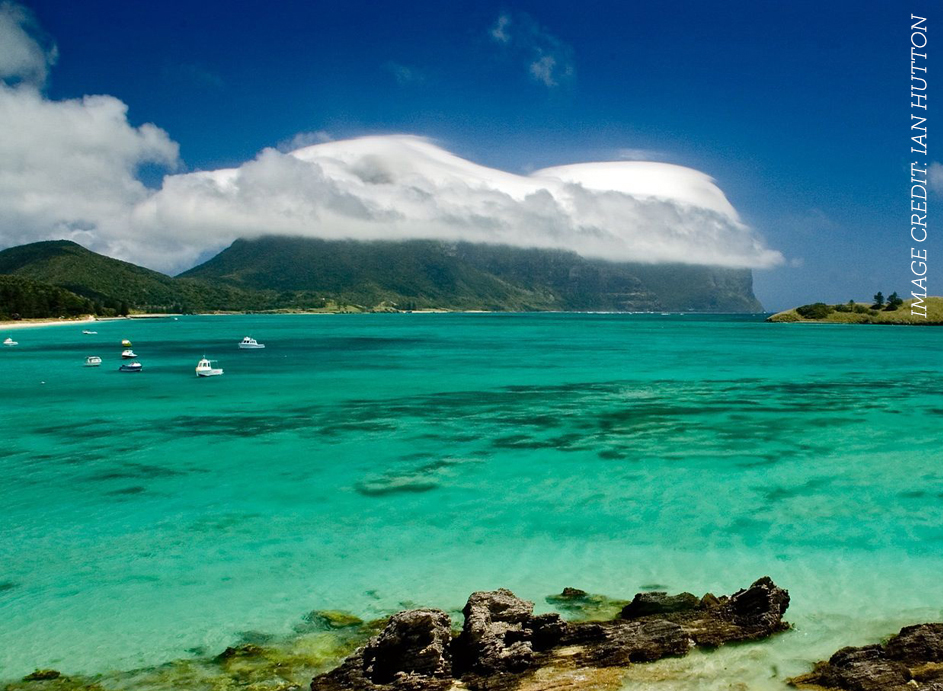Six hundred kilometres off the coast of New South Wales, Lord Howe Island boasts outstanding natural landscapes and species, found nowhere else in the world. It is also home to the world’s most southern coral reef. Because of its truly unique biodiversity, the island was granted UNESCO World Heritage status in 1982. To conserve its natural beauty, 75% of the island is protected for conservation purposes. The island is also surrounded by a unique marine park that is home to 500 fish species and 90 coral species, many of which are not found anywhere else in the world.
Climate change is already affecting the island’s critically endangered forests, coral reefs, and the local economy that is reliant upon them.

Image Credit: Ian Hutton – Aerial view of Lord Howe Island
The island’s Gnarled Mossy Cloud Forest — a closed-canopy forest that’s up to 8 metres tall in some places — is a Critically Endangered Ecological Community under NSW law. It is also home to 86% of the endemic plant species on the island.¹ This forest is a globally unique ecosystem as it is found only on the two peaks of Lord Howe Island, at altitudes of over 750m.¹ This unique ecosystem is directly threatened by climate change as the average temperature rises and rainfall and cloud cover become more variable.¹
Temperatures have risen over the past century, and are expected to continue to increase in the future. The Gnarled Mossy Cloud Forest is particularly vulnerable to rising temperatures because it is situated on the summit of two mountain peaks and so cannot move to a higher altitude to adjust.
There has also been a 31% decline in annual rainfall over the past 50 years on Lord Howe Island. Lord Howe experienced its lowest annual rainfall in 2018 (984.6 mm), according to data collected by the Bureau of Meteorology (BOM). Lord Howe also had its driest December on record in 2018, with just 8.2 mm of rainfall, and its driest January on record in 2019, with only 1 mm of rainfall during the month, less than 1% of what the island would usually see at that time of year. In the future, rainfall variability is projected to increase.

Image Credit: Ian Hutton – The same summit, before and after this dry summer.
Since 1945, there has been a long-term decline in the proportion of days with cloud cover around the mountain peaks on Lord Howe Island.¹ The semi-permanent cloud layer is important in sustaining the Gnarled Mossy Cloud Forest, as it provides the moisture and humidity needed to keep the unique plant communities alive.¹ This is particularly vital during periods of low rainfall. Cloud loss also increases the direct solar radiation exposure which heats and dries out the canopy, threatening the existence of this unique forest. As sea surface temperatures continue to rise with climate change, scientists anticipate this will increase the altitude at which clouds form over tropical mountains, adding further pressure to the ecosystem.

Image Credit: Ian Hutton – Typical cloud layer over the summit, view from the beach
A warming climate also drives more severe storm events, which threaten the survival of adult trees in the Gnarled Mossy Cloud Forest due to storm damage¹. Stronger storms also threaten the island’s shoreline and shallow reefs that are vulnerable to wave erosion and sea level rise. As the world’s most southern coral reef, the cold water corals are part of what make it so unique. However, scientists believe ocean warming and acidification will threaten cold water coral species more than their warm water counterparts.
Less than 500 people live full-time on the island, so the 15,000 annual tourists (limited to 400 at any one time for ecological reasons) are vital to the island’s economy. More than 50% of Lord Howe residents are employed in tourism-related industries. With climate change driving more severe extreme weather events, Lord Howe Island is at risk of losing the natural environments that make it globally unique, and the tourism industry that is dependent on it.
To read more about climate change impacts on Australia’s $43 billion tourism industry, check our our full tourism report ‘Icons at Risk: Climate Change Threatening Australian Tourism’.
- Auld, T. D., & Leishman, M. R. (2015). Ecosystem risk assessment for Gnarled Mossy Cloud Forest, Lord Howe Island, Australia. Austral Ecology, 40(4), 364-372. https://doi.org/10.1111/aec.12202